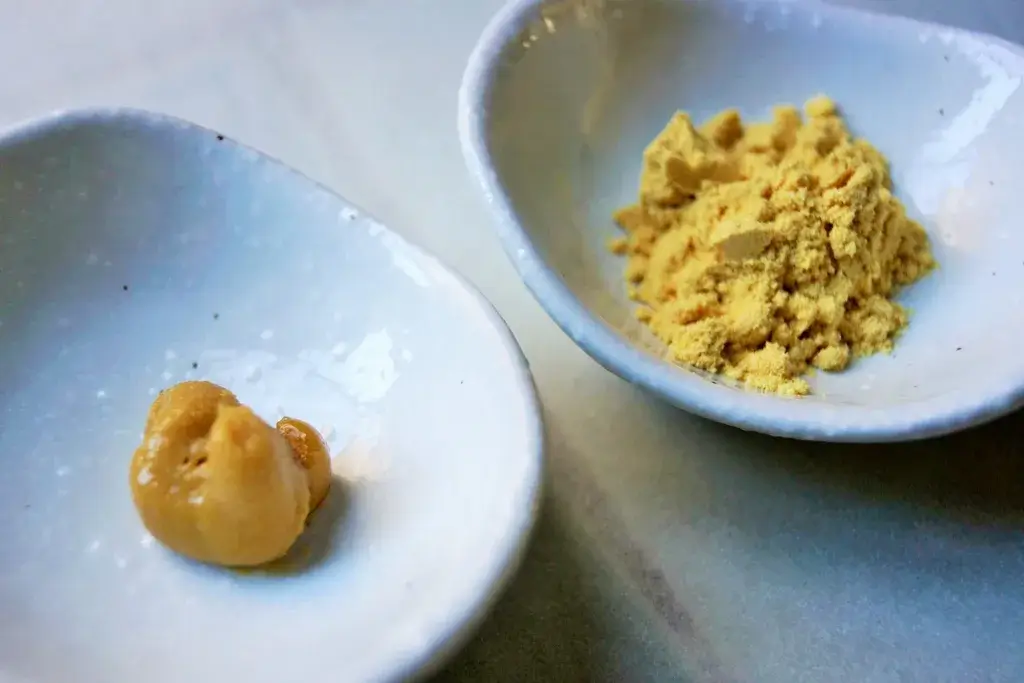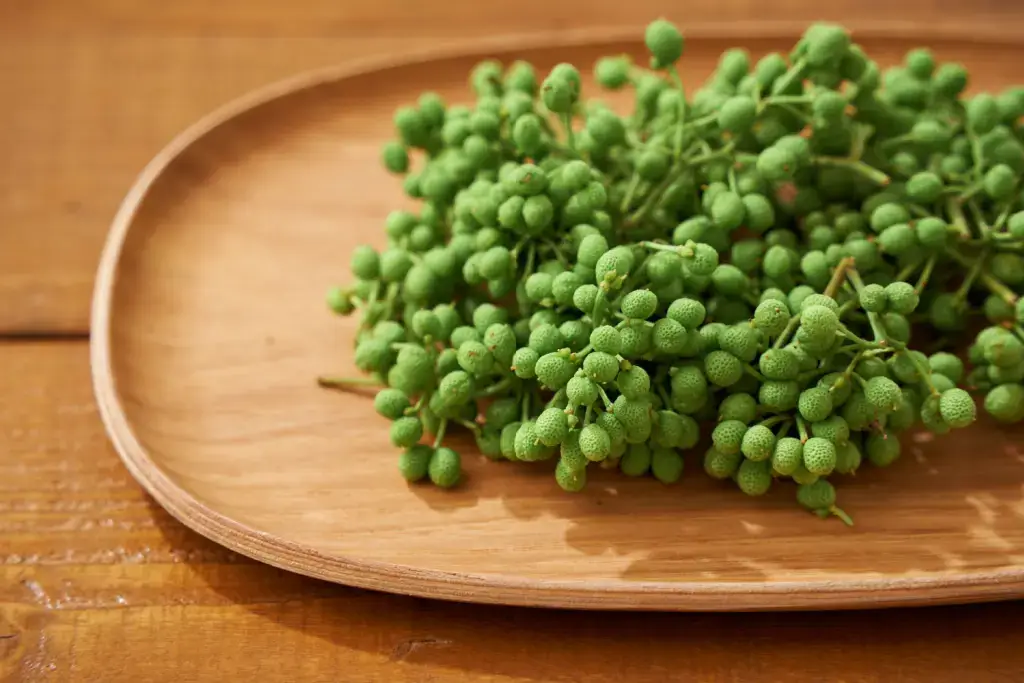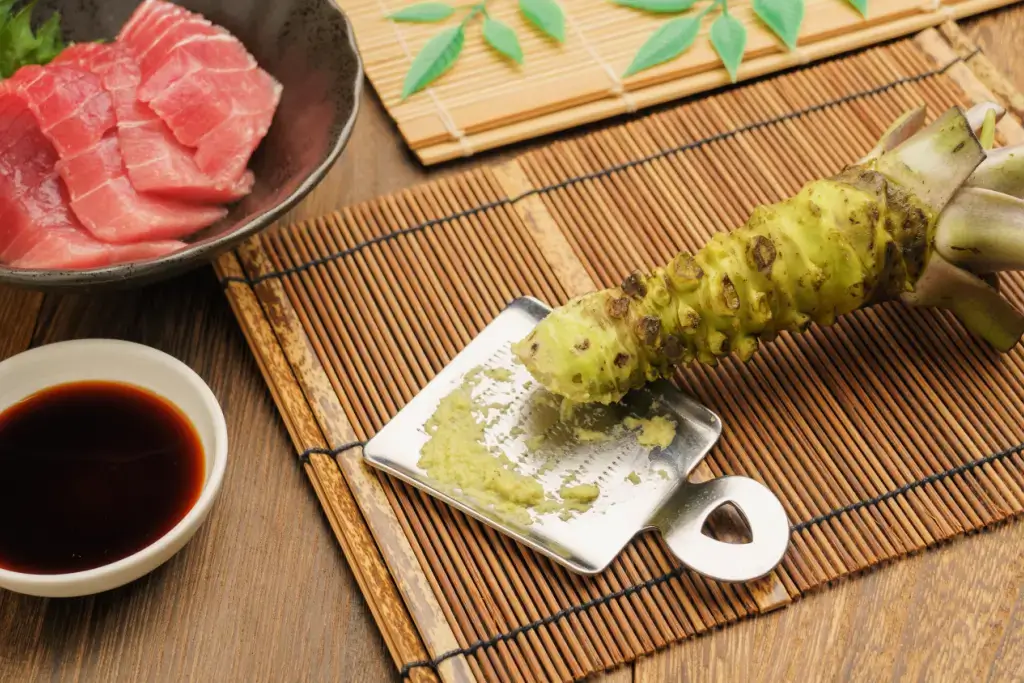karashi, spicy condiments
Karashi and More Japanese Spices to Enjoy!

Devon Lord-Moncrief
Posted on August 26, 2024
Share:

Japanese cuisine is famous worldwide for its wide range of delicacies, from the finest noodles to the most succulent sushi. Regardless of what dish you may dine on, your meal will benefit from adding Japan’s most famous spices and seasonings. Any cook and foodie worth their salt knows that the perfect spice can elevate a great dish to a divine one. Come learn about some of the most popular spices used in Japanese cuisine!
Karashi
Made from crushed brown mustard seeds, karashi is a classic Japanese spice that accompanies many different dishes across the country. You can buy karashi either premade or in dry powder form. If you purchase it as a powder, preparing it is simple: mix it with water and let it sit for several minutes to develop fully.

Once ready, you can use karashi as a condiment for foods like shumai, oden, and tonkatsu. Made from brown mustard seeds, karashi has a spicy and sharp flavor that can effectively clear your nose. Mix karashi with mayonnaise, miso, and vinegar if you prefer a milder taste.
Shichimi
Also known as shichimi tōgarashi, or “seven-flavor chili pepper,” shichimi is a classic Japanese spice that dates back to the 17th century. Traditionally prepared in Edo, present-day Tokyo, shichimi is one of Japan’s most common spice blends. Just as people in the West find salt and pepper shakers on their tables, you can also find shichimi on tables in Japan.

Shichimi is spicy and pungent, offering great depth and versatility. It can be used in rice, noodles, meat, and vegetables. The spice blend includes red chili pepper, sansho, roasted orange peel, black sesame seed, white sesame seed, hemp seed, ginger, nori, poppy seed, and yuzu peel. Shichimi combines many traditional Japanese flavors into one product. It provides an authentic taste that complements noodle dishes and various soups.
Sansho Pepper

A versatile plant native to Japan, the sansho pepper is related to the Chinese Sichuan pepper. When the plant’s berries ripen and grow large, farmers cultivate them for various uses. Most commonly, they crush the berries to create a spice. Sansho peppers are one of the seven key spices in shichimi. They also add flavor to famous broiled eel. Additionally, the shoots and leaves of young plants top soups and grilled fish. While sansho peppers are not as hot as habanero or ghost pepper, people sensitive to capsaicin should still avoid it.
Are you looking for spicy snacks? Check out Sakuraco! Every month, Sakuraco delivers delicious Japanese snacks, teas, and sweets from Japan so you may enjoy them at home.
Chili Oil
As its name implies, chili oil is a condiment consisting of vegetable oil infused with chili peppers. It is a spicy condiment that enhances dishes and should be used sparingly by those sensitive to heat. While the oil can reduce the potency of the chilis steeped in it, it still retains a significant amount of the peppers’ natural heat.

In Japan, various chili oils, known as rayu, are very popular. Chefs typically use sesame oil and red chili peppers. Sometimes, they add ingredients like ginger, paprika, and turmeric to create different flavor profiles. Chili oil is a versatile condiment that pairs well with rice, meat, vegetables, and even soups.
Wasabi
Perhaps the most famous and most easily recognizable of Japanese spices is wasabi. Famous for its accompaniment with sushi and infamous for its heat, wasabi is made from the ground stems of the Japanese horseradish plant. Related to other horseradish varieties and mustard plants, wasabi is a potent and spicy plant that notoriously burns the nose moreso than the mouth.

When eaten in moderation with sushi, wasabi can have a wonderfully deep and aromatic flavor that perfectly compliments the sweet umami of sushi. As authentic Japanese wasabi can be difficult and expensive to harvest in significant amounts, wasabi served in the West is very fittingly known as Western wasabi; as such, these products do not use actual Japanese wasabi but regular Western horseradish instead. When not eaten with sushi, wasabi is a popular flavoring for many different snacks, with dried peas being a typical snack.
Why should I try spicy condiments like karashi?
Spicy food is certainly not for everybody. For some, spiciness can detract from the enjoyment of a meal or even be outright painful. But for those with a taste and a tolerance for spice, few things can add depth and enjoyment to a meal quite the way spicy condiments can. In Japan, many base dishes are quite simple.

While many ingredients, such as mirin, teriyaki, and many different fish products, can be sweet, incorporating a spicy condiment or additive to a meal can completely change the entire flavor profile. There is a fine line between spiciness for flavor and spiciness for pain. In Japan (wasabi aside), most spices add phenomenal flavor to delicious foods.
What are some of your favorite Japanese spices? Did we include them in this list? If not, what are they, and where can they be found? Please let us know in the comments below! We would love to hear about your favorite Japanese spices!

Discover authentic flavors with Sakuraco
Get Sakuraco 

Discover authentic flavors with Sakuraco
Get Sakuraco 
Related Articles

Mochi: How is Mochitsuki Made in Japan?
Mochitsuki is the Japanese tradition of pounding steamed rice to make mochi for the New Year. Families and neighbors gather to participate in this lively and meaningful tradition. The teamwork involved helps everyone feel a sense of connection.

Konpeito Candy: What Makes This Starry Treat Shine?
If you are a fan of the famous Demon Slayer series, then you probably know that the favorite treat of the adorable Nezuko Kamado is those tiny, colorful little sweets.

Kinako: The Amazing Roasted Soybean Powder!
Kinako is a very popular ingredient that can easily be found in many traditional Japanese sweets. It has a distinctive flavor, standing alongside other classic tastes such as red bean or sesame. Let’s explore this charming ingredient together, and who knows, you might even be able to make it in your own beloved kitchen!

Aaron and Claire Make the Ultimate Japanese Pork Belly: Buta no Kakuni
If you want a Japanese dish that’s rich, tender, and simple to follow, Aaron and Claire show exactly how to make it in this episode. Aaron prepares Buta no Kakuni, a classic braised pork belly dish renowned for its rich flavor and tender texture.



